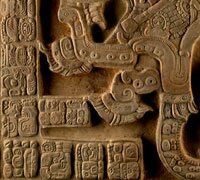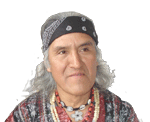MAYA LANGUAGE GUIDE
OVERVIEW
 Ancient Maya writing used hieroglyphs, pictorial representations that were carved in stone and other materials, painted on pottery and murals, or written in books. Glyphs were always used for writing, not for decoration. The hieroglyphic code of the Maya was undecipherable to modern scholars until quite recently. Now it is understood that the Maya script was a logo-syllabic system. Individual symbols ("glyphs") could represent either a word or a syllable; indeed, the same glyph could often be used for both.
Ancient Maya writing used hieroglyphs, pictorial representations that were carved in stone and other materials, painted on pottery and murals, or written in books. Glyphs were always used for writing, not for decoration. The hieroglyphic code of the Maya was undecipherable to modern scholars until quite recently. Now it is understood that the Maya script was a logo-syllabic system. Individual symbols ("glyphs") could represent either a word or a syllable; indeed, the same glyph could often be used for both.
Maya glyphs appeared on the face of buildings, on carvings, in books and murals. They described the everyday life of the cities and rulers and were also used to record astrological and astronomical events.
Maya scribes played a crucial role in the court as the keepers of information, as the commoners in ancient Maya society were most likely illiterate. It was the scribe’s role to preserve the power of the king through writing. Scribes could be men or women, were in the upper class, and lived in luxury, beholden to the king.
Vowels and Consonants
There are about 30 vowel and consonant sounds in the Maya language.
- Vowels
- a - like 'ah' as in father
- e - like 'eh' as in left
- i - like the'ee' in tree
- o - like the 'o' in bone
- u - like the 'oo' in zoo
- Consonants
- b - at end of word like 'P'
- c - hard like English 'k'
- ch - pronounced as 'tsh'
- j - pronouced like hard 'h'
- l - almost silent at end of word
- Consonants continued...
- pp - as an explosive 'p'
- th - as an explosive 't'
- ts - like the first 'ch' in church
- tz or dz - just like it looks
- x - pronounced like 'sh'
Humberto Ak’abal

A Guatemalan poet Humberto Ak’abal wrote the following poems in the 1950’s. While the poems are not written in Yucatec Mayan, you can still practice your use of the Mayan language by reading them aloud referring to the pronunciation guide above. The Spanish and English translations follow.
We kateq’an puwi’jum ri’j k’isis
we katopan pa ri utza’m ri uq’ab
kawilo chi ri uwächulew
man naj tl k’o wi che ri kaj.
Pa chuwitz’ap
katkuwinik kachapo.
Yaj, xyajik
Ri ik’ are ri jun nimalaj ja
t’uyul puwi’ri uworachak ri juyub’
Are chi’ru nutat kinnuyajo
Ri we in kin’e pa ri ik’
Chila kinwar wi.
Si te encaramás a un Viejo ciprés
y trepás por sus ramas,
verás que la tierra
no está lejos del cielo.
En Momostenango
podrás tocarlo.
Regaňo
La luna era una casa grande
sentada sobre el espinazo del cerro.
Cuando mi papá me reganaba,
yo me iba para la luna
Y alli dormía.
If you rise to the top of the old cypress
and climb onto its branches
you will see the Earth
It’s not so far from the sky.
In Momostenango
you can touch it.
Scolding
The moon was a big house
sitting on the spine of the hill.
When my father scolded me
I went to the moon
And slept there.
LINGUISTIC GROUPS
There are more than seven million Maya living today in the Americas and Europe. They do not create glyphs as the ancients did, but their language is still unique.
There are 30 Maya languages spoken in Mesoamerica; 10 linguistic families with about 3 language variants each. People who speak languages from different linguistic families cannot typically understand each other. The ancient hieroglyphic script is most closely related to the following spoken languages today: chorti (near Copan in Honduras), Yucatec (Yucatan peninsula), and Chol (near Palenque in Chiapas).
Examples from the Yucatec Language
One of the largest Maya linguistic groups speaks Yucatec Mayan. Some examples of how English phrases would sound in Yucatec Mayan follow.
- English
- "Hi, how are you all?"
- "I am fine"
- "Thank you"
- "You’re welcome"
- Maya equivalent
- "Bix a belex?"
- "Maloob"
- "Yum botic"
- "Mixba’a"
- Maya pronunciation
- Beesh ah behlehsh?
- Mah-lohb
- Yoom boh-teek
- Meesh-ba-a


